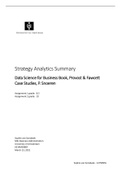Samenvatting
Summary course Strategy Analytics (Grade Assignments 9)
- Instelling
- Universiteit Van Amsterdam (UvA)
Complete summary of: - Book: Data Science for Business (Provost & Fawcett) - Case studies summary and answers (P. Snoeren) All exam materials needed next to the lecture slides!
[Meer zien]





